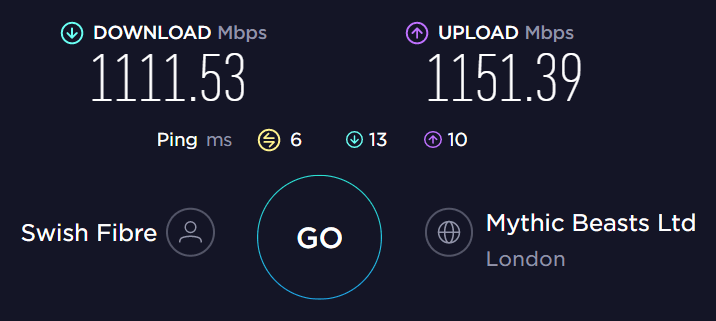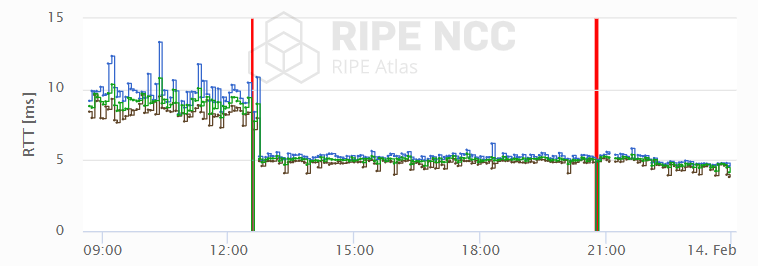Swish Fibre: An Early Review
My home was recently connected to Swish Fibre’s new network in Haywards Heath, so I thought I’d share my thoughts on their product.
I took their “Swish 900” residential package which promises download and upload speeds of 900Mbps. As expected I get speeds in excess of 900Mbps when testing with Ookla’s Speedtest.net. This isn’t just against Swish’s own server, but also other nearby servers (e.g. Mythic Beasts). Initially I measured speeds of 946Mbps, matching up with the expected throughput on gigabit ethernet. I then decided to try upgrading the SFP+ WAN interface on my router from one gigabit to ten gigabits and I was surprised to see even faster speeds of over 1,100Mbps! Swish’s symmetrical speeds are refreshing as internet connections from Openreach-based providers and Virgin Media are heavily asymmetrical – for example, at the time of writing the fastest broadband connection offered by Virgin only had an upload speed of 52Mbps.
Internet connections aren’t just about speed though – latency is important too (ask gamers or people trying to use remote desktop software, for example). I host a RIPE Atlas probe (ID 1002782) on my network. It takes independent measurements of the wider internet from the perspective of my internet provider. Swish’s network is superior in this aspect too: when I switched my network connection from IDNet (using Openreach) to Swish, I saw reductions in latency across the board. For example, the latency to the d-root nameserver reduce from a median of 9.1ms to a median of 4.6ms.
Swish provide two pieces of equipment to facilitate connection to their network: an Optical Network Terminal (I got a Swish-branded Adtran 622v) and a Plume SuperPod router (you don’t need to pay Plume’s membership fee). That said, I don’t use their router as I’ve already fitted my home with ceiling-mounted wireless access points from Ubiquiti. Using my own router couldn’t be easier as Swish use DHCP (no PPPoE or other configuration required). The engineers who completed the installation did a great job – I was able to have everything hidden in the cupboard with my other networking equipment, and the fibre optic cable was run neatly above the door frames. I didn’t cancel my old broadband connection until I’d tested that the new connection was working – this gave me peace of mind during the switchover process.
So far I’ve been very positive – and with good reason, overall I’m impressed with Swish’s service. That said, I think there’s a significant (if not somewhat nerdy) area where their service could be enhanced. By default Swish use Carrier-Grade NAT for IPv4, and charge £3 per month for a public IP address. This isn’t unreasonable as IPv4 addresses are running out, however Swish do not offer IPv6, the long term solution to IPv4 exhaustion. In my opinion this is poor – the first IPv6 specification was published in 1995 so any new internet provider should support it immediately.
In summary I think Swish’s service is an excellent upgrade from services offered by Openreach-based providers or Virgin Media. I look forward to seeing how the market evolves, both as Swish is consolidated as part of Fern Fibre’s family of networks and as more providers build throughout the UK.


